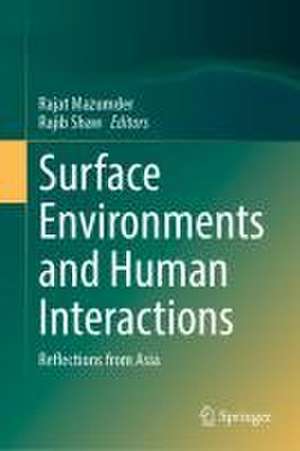Surface Environments and Human Interactions: Reflections from Asia
Editat de Rajat Mazumder, Rajib Shawen Limba Engleză Hardback – 13 mar 2024
Preț: 894.46 lei
Preț vechi: 1090.81 lei
-18% Nou
Puncte Express: 1342
Preț estimativ în valută:
171.17€ • 178.48$ • 142.26£
171.17€ • 178.48$ • 142.26£
Carte disponibilă
Livrare economică 27 februarie-13 martie
Preluare comenzi: 021 569.72.76
Specificații
ISBN-13: 9789819701117
ISBN-10: 9819701112
Pagini: 231
Ilustrații: XIV, 231 p. 1 illus.
Dimensiuni: 155 x 235 mm
Greutate: 0.54 kg
Ediția:2024
Editura: Springer Nature Singapore
Colecția Springer
Locul publicării:Singapore, Singapore
ISBN-10: 9819701112
Pagini: 231
Ilustrații: XIV, 231 p. 1 illus.
Dimensiuni: 155 x 235 mm
Greutate: 0.54 kg
Ediția:2024
Editura: Springer Nature Singapore
Colecția Springer
Locul publicării:Singapore, Singapore
Cuprins
Chapter 1. A study of the temporal variation in the bars, bedforms and riparian population in the downstream stretch of Tista River, Eastern Himalaya: impact of the upstream river regulation.- Chapter 2. Evolution of modern sedimentation patterns in the Himalayan Ganges River Alluvial Flood Plain.- Chapter 3. Interplay between Sediment Transport and Urbanization in Wadi Environments.- Chapter 4. Geological characteristics, and landslide risk reduction.- Chapter 5. Landslide, Land Cover, and Land use Changes and its implications in disaster risks in Nepal.- Chapter 6. Paleo-sediments deposits, and implications to tsunami risk.- Chapter 7. Sedimentary evidence of past tsunami deposits in Aceh, Indonesia.- Chapter 8. Landslide susceptibility modelling in Malaysia: insights from sedimentology.- Chapter 9. Landslide susceptibility in western part of China.- Chapter 10. Sundarbans estuarine system of India: sedimentation, morphodynamics, and human interactions.- Chapter 11. Microbially induced sedimentary processes in the intertidal regions, Sundarbans, India.
Notă biografică
Dr. Rajat Mazumder received his M. Sc in Applied Geology in 1991 from the University of Allahabad, (India) and his Ph. D from Jadavpur University (India) in 2002. He was a Post-doctoral Fellow of the Japan Society for the Promotion of Science (JSPS) at Yokohama National University (2002-2004), Alexander Von Humboldt Foundation (2005-2006) at Munich University, Germany, and was a recipient of JSPS short-term invitation fellowship for experienced researchers in 2008. Dr. Mazumder taught Sedimentary Petrology, Mineralogy, and Precambrian Stratigraphy at Asutosh College (University of Calcutta, 1999-2002), Indian Institute of Technology Roorkee (2006), and was an Associate Professor of Geology at the Indian Statistical Institute (2006-2013). He was a Research Fellow at the University of New South Wales Australia (2012-2014) and an Associate Professor at Curtin University, Malaysia (2015-2018). Currently, Dr. Mazumder is an Associate Professor at the German University of Technology in Oman.Dr. Mazumder was one of the global co-leaders of the UNESCO-IGCP 509 research project (2005-2009) on the Paleoproterozoic Supercontinent and global evolution. He is an editorial board member of Geology (Geological Society of America), and Sedimentology (journal of the International Association of Sedimentologists, Europe). His research mostly focuses on the Earth’s surface processes during its early history.
Dr. Rajib Shaw is a professor in the Graduate School of Media and Governance at Keio University, Japan. He co-founded a Delhi (India) social entrepreneur startup Resilience Innovation Knowledge Academy (RIKA), and RIKA Institute. He is the Co-chair of the United Nations Asia Pacific Science Technology Advisory Group (AP-STAG) and was CLA for IPCC’s 6th Assessment Report. Professor Shaw is the recipient of the prestigious “Pravasi Bharatiya Samman Award (PBSA)” in 2021 for his contribution to the education sector. He also received the United Nations Sasakawa Award in 2022 for his lifetime contributions to disaster risk reduction. He is the editor-in-chief of Progress in Disaster Science, a high-impact factor Elsevier journal. He published 66 books and over 450 research papers. More about his work can be found at: www.rajibshaw.org
Textul de pe ultima copertă
This book describes the complex interplay between Earth's surface processes (erosion and sedimentation) and human interactions. Intensive as well as extensive research has been undertaken to infer modern sedimentation processes and to infer the mode of stratigraphic sequence building. However, the effort to understand the influence of sedimentation processes on society and the human impact on sedimentation is long overdue. This is a new upcoming multidisciplinary research field that is beyond the scope of leading traditional Earth and Environmental Science journals. To fill in the prodigious gap in the knowledge base, this book includes in-depth reviews and new data-based case studies from Asia, involving multidisciplinary research. It covers case studies of risk management of various hazards and risk management systems at regional, national, and local levels. The book proposes a comprehensive approach to reducing future risks by collaborating with various stakeholders and preparing for the most effective responses towards complicated hazards, minimizing social damage. This publication will help researchers in the field of Environment and Earth surface processes, disaster risk reduction, and geoscientists to have a better idea of the current trend of research in the field and will provide updated synthesis on this important topic.
Caracteristici
Illustrates the complex interplay between surface environments and human society First attempt to link human interaction with surface environments Draws lessons from field data, case studies and ground realities
